A Critical Review of Obsessive Compulsive Disorder (OCD) in India
VerifiedAdded on 2021/05/31
|32
|9609
|15
Report
AI Summary
This report provides a critical review of Obsessive Compulsive Disorder (OCD) in India, focusing on the neglect of children with the disorder by parents and the public's lack of understanding. It explores the study's aims, which include informing parents, teachers, and the public about the causes and treatments for OCD. The report delves into the behaviors associated with OCD, distinguishing between obsessions (unwanted intrusive thoughts) and compulsions (repetitive acts). It further categorizes these into mental and observable forms, providing examples of each. The report also examines the causes of OCD, highlighting the roles of teachers, health practitioners, and the government. It includes statistical data on the prevalence of OCD in India, emphasizing the high rates among children and the challenges parents face in accepting and addressing their children's condition. The report aims to provide a deeper understanding of the disorder, its impact, and potential interventions, with a focus on improving the lives of those affected by OCD in India.
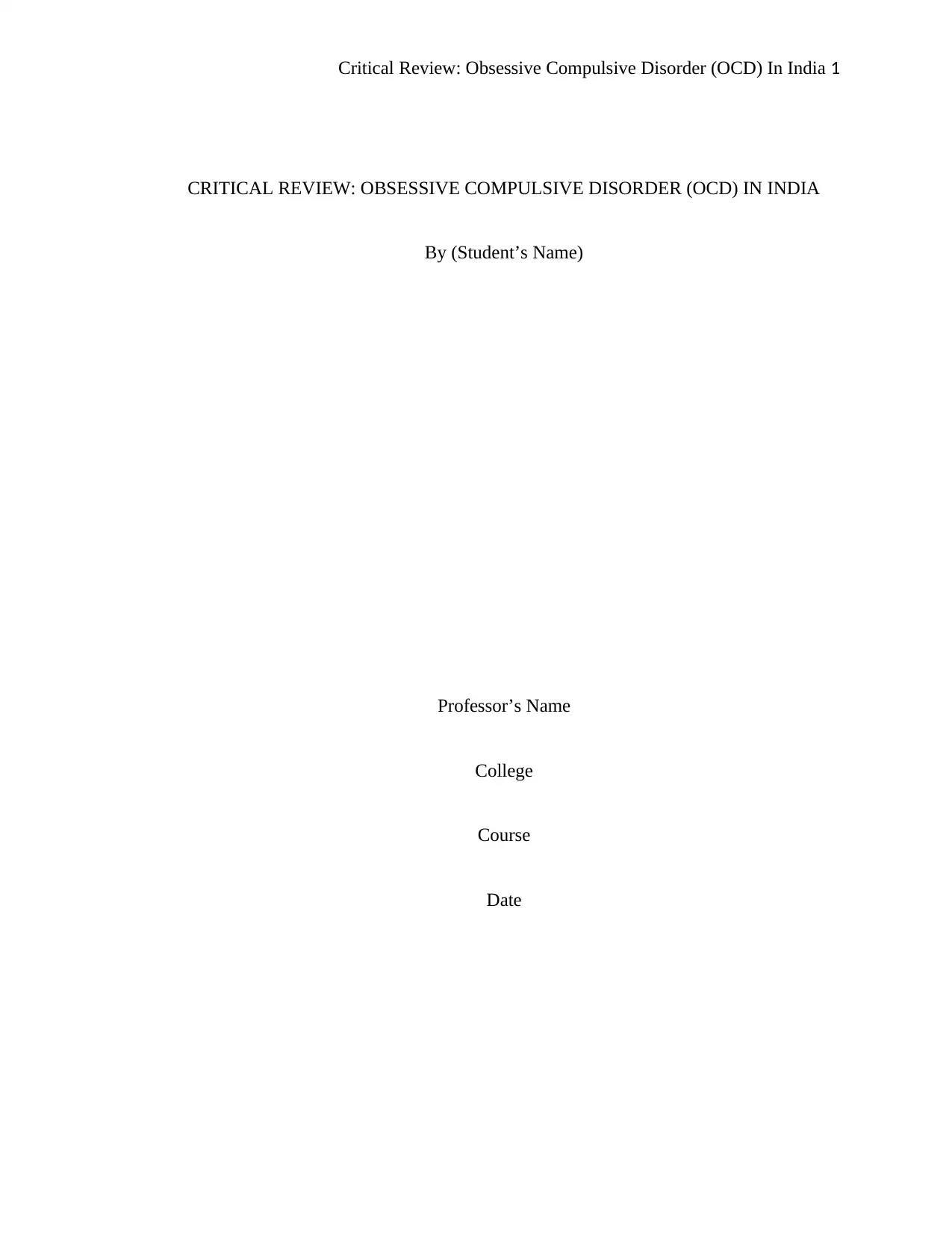
Critical Review: Obsessive Compulsive Disorder (OCD) In India 1
CRITICAL REVIEW: OBSESSIVE COMPULSIVE DISORDER (OCD) IN INDIA
By (Student’s Name)
Professor’s Name
College
Course
Date
CRITICAL REVIEW: OBSESSIVE COMPULSIVE DISORDER (OCD) IN INDIA
By (Student’s Name)
Professor’s Name
College
Course
Date
Paraphrase This Document
Need a fresh take? Get an instant paraphrase of this document with our AI Paraphraser
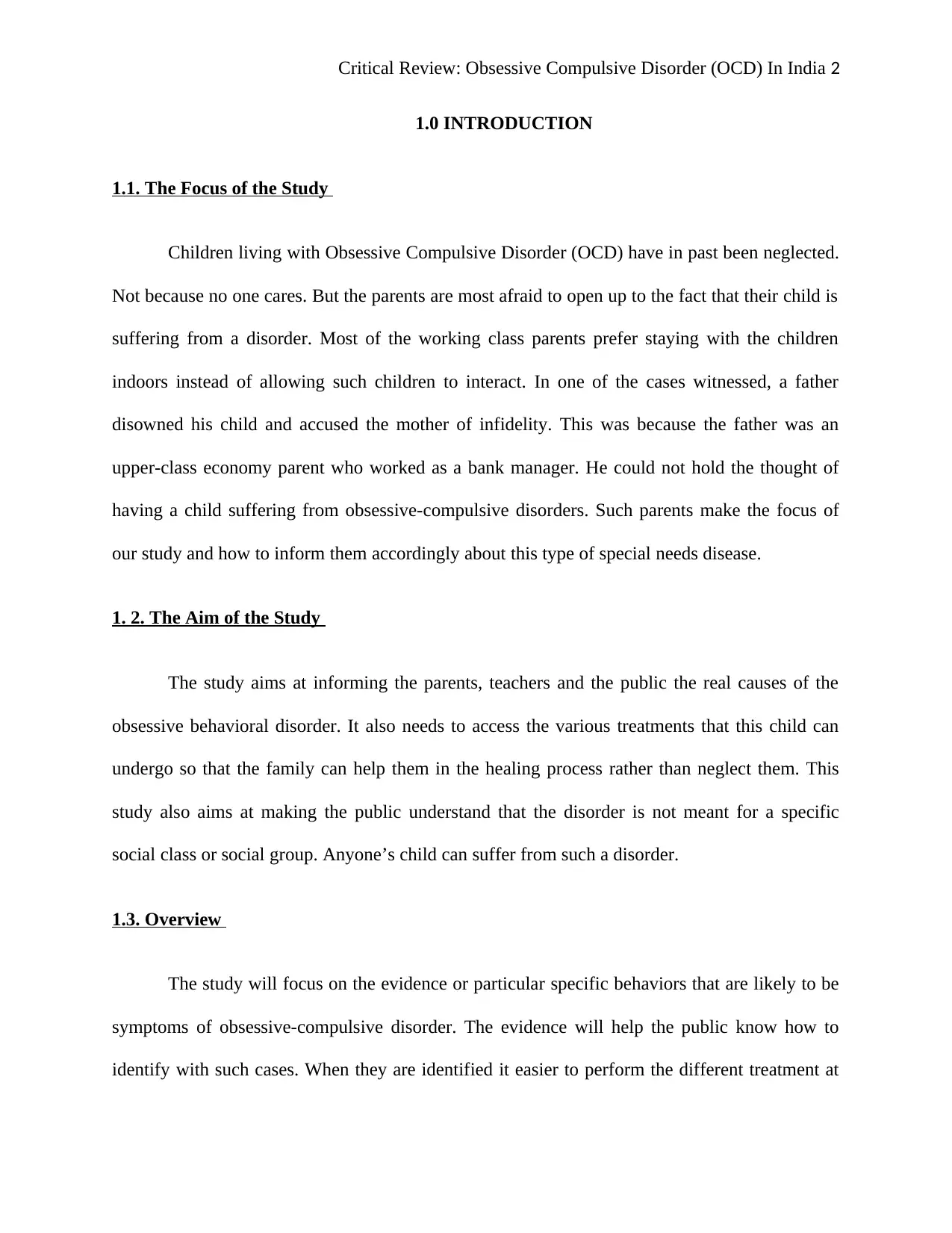
Critical Review: Obsessive Compulsive Disorder (OCD) In India 2
1.0 INTRODUCTION
1.1. The Focus of the Study
Children living with Obsessive Compulsive Disorder (OCD) have in past been neglected.
Not because no one cares. But the parents are most afraid to open up to the fact that their child is
suffering from a disorder. Most of the working class parents prefer staying with the children
indoors instead of allowing such children to interact. In one of the cases witnessed, a father
disowned his child and accused the mother of infidelity. This was because the father was an
upper-class economy parent who worked as a bank manager. He could not hold the thought of
having a child suffering from obsessive-compulsive disorders. Such parents make the focus of
our study and how to inform them accordingly about this type of special needs disease.
1. 2. The Aim of the Study
The study aims at informing the parents, teachers and the public the real causes of the
obsessive behavioral disorder. It also needs to access the various treatments that this child can
undergo so that the family can help them in the healing process rather than neglect them. This
study also aims at making the public understand that the disorder is not meant for a specific
social class or social group. Anyone’s child can suffer from such a disorder.
1.3. Overview
The study will focus on the evidence or particular specific behaviors that are likely to be
symptoms of obsessive-compulsive disorder. The evidence will help the public know how to
identify with such cases. When they are identified it easier to perform the different treatment at
1.0 INTRODUCTION
1.1. The Focus of the Study
Children living with Obsessive Compulsive Disorder (OCD) have in past been neglected.
Not because no one cares. But the parents are most afraid to open up to the fact that their child is
suffering from a disorder. Most of the working class parents prefer staying with the children
indoors instead of allowing such children to interact. In one of the cases witnessed, a father
disowned his child and accused the mother of infidelity. This was because the father was an
upper-class economy parent who worked as a bank manager. He could not hold the thought of
having a child suffering from obsessive-compulsive disorders. Such parents make the focus of
our study and how to inform them accordingly about this type of special needs disease.
1. 2. The Aim of the Study
The study aims at informing the parents, teachers and the public the real causes of the
obsessive behavioral disorder. It also needs to access the various treatments that this child can
undergo so that the family can help them in the healing process rather than neglect them. This
study also aims at making the public understand that the disorder is not meant for a specific
social class or social group. Anyone’s child can suffer from such a disorder.
1.3. Overview
The study will focus on the evidence or particular specific behaviors that are likely to be
symptoms of obsessive-compulsive disorder. The evidence will help the public know how to
identify with such cases. When they are identified it easier to perform the different treatment at
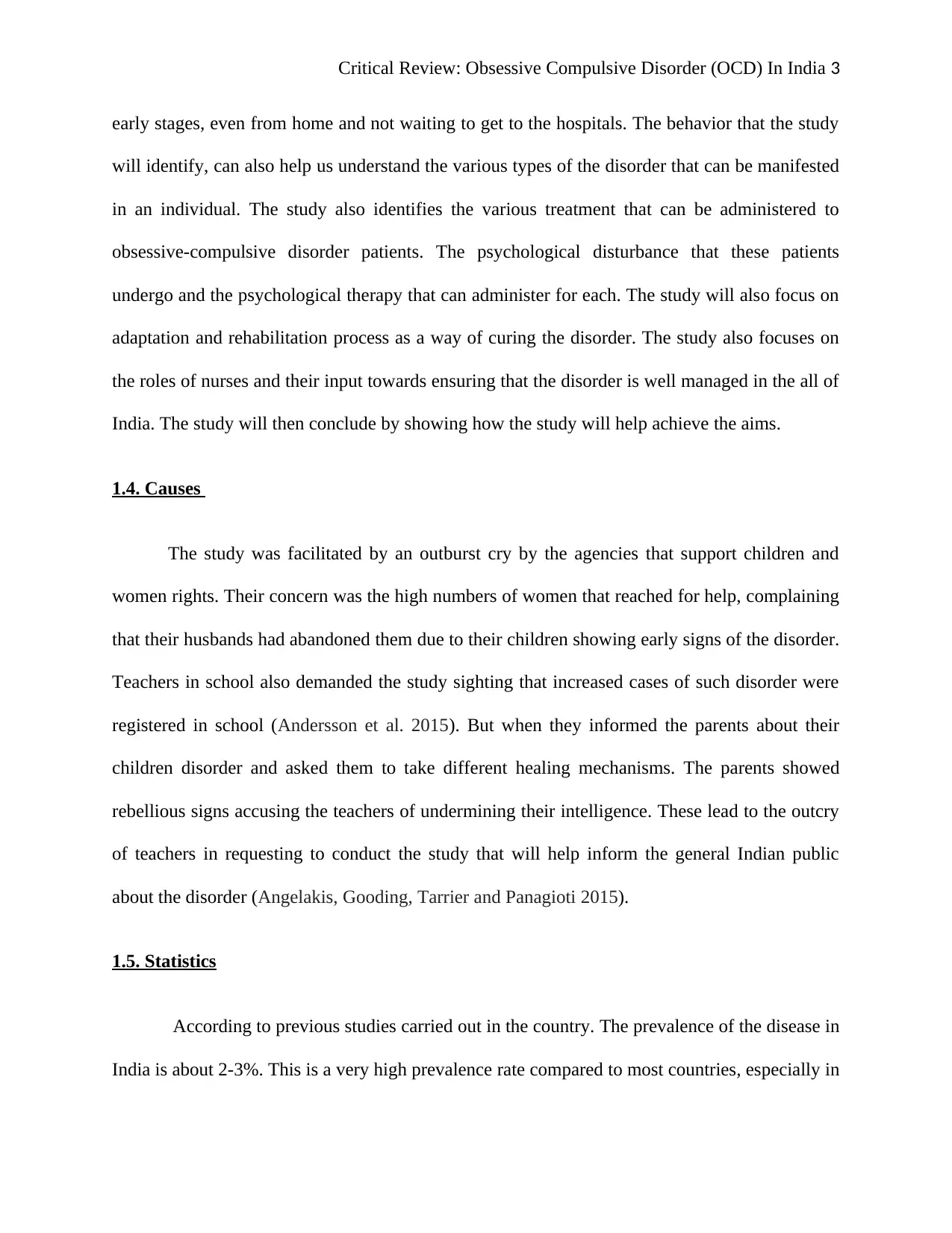
Critical Review: Obsessive Compulsive Disorder (OCD) In India 3
early stages, even from home and not waiting to get to the hospitals. The behavior that the study
will identify, can also help us understand the various types of the disorder that can be manifested
in an individual. The study also identifies the various treatment that can be administered to
obsessive-compulsive disorder patients. The psychological disturbance that these patients
undergo and the psychological therapy that can administer for each. The study will also focus on
adaptation and rehabilitation process as a way of curing the disorder. The study also focuses on
the roles of nurses and their input towards ensuring that the disorder is well managed in the all of
India. The study will then conclude by showing how the study will help achieve the aims.
1.4. Causes
The study was facilitated by an outburst cry by the agencies that support children and
women rights. Their concern was the high numbers of women that reached for help, complaining
that their husbands had abandoned them due to their children showing early signs of the disorder.
Teachers in school also demanded the study sighting that increased cases of such disorder were
registered in school (Andersson et al. 2015). But when they informed the parents about their
children disorder and asked them to take different healing mechanisms. The parents showed
rebellious signs accusing the teachers of undermining their intelligence. These lead to the outcry
of teachers in requesting to conduct the study that will help inform the general Indian public
about the disorder (Angelakis, Gooding, Tarrier and Panagioti 2015).
1.5. Statistics
According to previous studies carried out in the country. The prevalence of the disease in
India is about 2-3%. This is a very high prevalence rate compared to most countries, especially in
early stages, even from home and not waiting to get to the hospitals. The behavior that the study
will identify, can also help us understand the various types of the disorder that can be manifested
in an individual. The study also identifies the various treatment that can be administered to
obsessive-compulsive disorder patients. The psychological disturbance that these patients
undergo and the psychological therapy that can administer for each. The study will also focus on
adaptation and rehabilitation process as a way of curing the disorder. The study also focuses on
the roles of nurses and their input towards ensuring that the disorder is well managed in the all of
India. The study will then conclude by showing how the study will help achieve the aims.
1.4. Causes
The study was facilitated by an outburst cry by the agencies that support children and
women rights. Their concern was the high numbers of women that reached for help, complaining
that their husbands had abandoned them due to their children showing early signs of the disorder.
Teachers in school also demanded the study sighting that increased cases of such disorder were
registered in school (Andersson et al. 2015). But when they informed the parents about their
children disorder and asked them to take different healing mechanisms. The parents showed
rebellious signs accusing the teachers of undermining their intelligence. These lead to the outcry
of teachers in requesting to conduct the study that will help inform the general Indian public
about the disorder (Angelakis, Gooding, Tarrier and Panagioti 2015).
1.5. Statistics
According to previous studies carried out in the country. The prevalence of the disease in
India is about 2-3%. This is a very high prevalence rate compared to most countries, especially in
⊘ This is a preview!⊘
Do you want full access?
Subscribe today to unlock all pages.

Trusted by 1+ million students worldwide
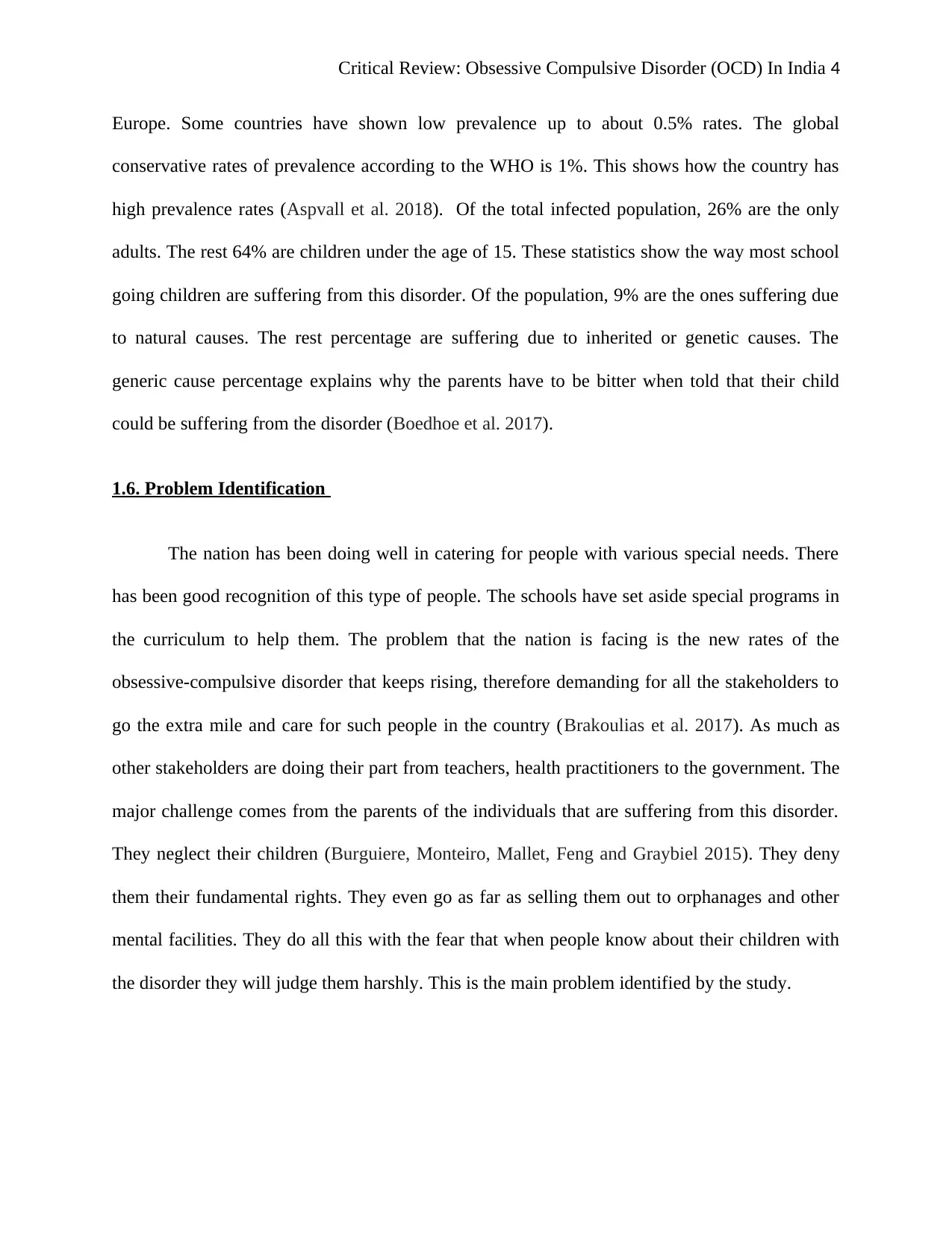
Critical Review: Obsessive Compulsive Disorder (OCD) In India 4
Europe. Some countries have shown low prevalence up to about 0.5% rates. The global
conservative rates of prevalence according to the WHO is 1%. This shows how the country has
high prevalence rates (Aspvall et al. 2018). Of the total infected population, 26% are the only
adults. The rest 64% are children under the age of 15. These statistics show the way most school
going children are suffering from this disorder. Of the population, 9% are the ones suffering due
to natural causes. The rest percentage are suffering due to inherited or genetic causes. The
generic cause percentage explains why the parents have to be bitter when told that their child
could be suffering from the disorder (Boedhoe et al. 2017).
1.6. Problem Identification
The nation has been doing well in catering for people with various special needs. There
has been good recognition of this type of people. The schools have set aside special programs in
the curriculum to help them. The problem that the nation is facing is the new rates of the
obsessive-compulsive disorder that keeps rising, therefore demanding for all the stakeholders to
go the extra mile and care for such people in the country (Brakoulias et al. 2017). As much as
other stakeholders are doing their part from teachers, health practitioners to the government. The
major challenge comes from the parents of the individuals that are suffering from this disorder.
They neglect their children (Burguiere, Monteiro, Mallet, Feng and Graybiel 2015). They deny
them their fundamental rights. They even go as far as selling them out to orphanages and other
mental facilities. They do all this with the fear that when people know about their children with
the disorder they will judge them harshly. This is the main problem identified by the study.
Europe. Some countries have shown low prevalence up to about 0.5% rates. The global
conservative rates of prevalence according to the WHO is 1%. This shows how the country has
high prevalence rates (Aspvall et al. 2018). Of the total infected population, 26% are the only
adults. The rest 64% are children under the age of 15. These statistics show the way most school
going children are suffering from this disorder. Of the population, 9% are the ones suffering due
to natural causes. The rest percentage are suffering due to inherited or genetic causes. The
generic cause percentage explains why the parents have to be bitter when told that their child
could be suffering from the disorder (Boedhoe et al. 2017).
1.6. Problem Identification
The nation has been doing well in catering for people with various special needs. There
has been good recognition of this type of people. The schools have set aside special programs in
the curriculum to help them. The problem that the nation is facing is the new rates of the
obsessive-compulsive disorder that keeps rising, therefore demanding for all the stakeholders to
go the extra mile and care for such people in the country (Brakoulias et al. 2017). As much as
other stakeholders are doing their part from teachers, health practitioners to the government. The
major challenge comes from the parents of the individuals that are suffering from this disorder.
They neglect their children (Burguiere, Monteiro, Mallet, Feng and Graybiel 2015). They deny
them their fundamental rights. They even go as far as selling them out to orphanages and other
mental facilities. They do all this with the fear that when people know about their children with
the disorder they will judge them harshly. This is the main problem identified by the study.
Paraphrase This Document
Need a fresh take? Get an instant paraphrase of this document with our AI Paraphraser
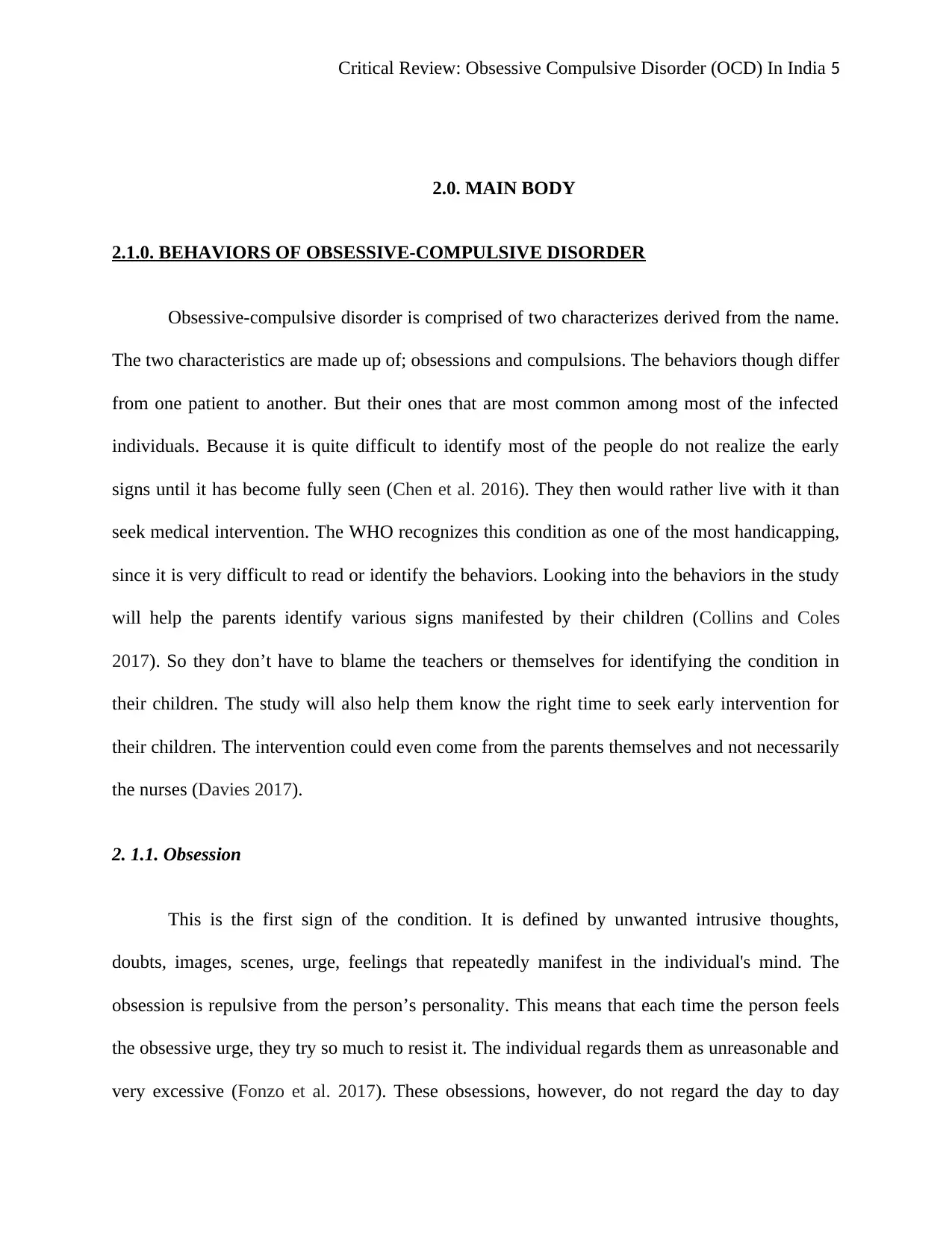
Critical Review: Obsessive Compulsive Disorder (OCD) In India 5
2.0. MAIN BODY
2.1.0. BEHAVIORS OF OBSESSIVE-COMPULSIVE DISORDER
Obsessive-compulsive disorder is comprised of two characterizes derived from the name.
The two characteristics are made up of; obsessions and compulsions. The behaviors though differ
from one patient to another. But their ones that are most common among most of the infected
individuals. Because it is quite difficult to identify most of the people do not realize the early
signs until it has become fully seen (Chen et al. 2016). They then would rather live with it than
seek medical intervention. The WHO recognizes this condition as one of the most handicapping,
since it is very difficult to read or identify the behaviors. Looking into the behaviors in the study
will help the parents identify various signs manifested by their children (Collins and Coles
2017). So they don’t have to blame the teachers or themselves for identifying the condition in
their children. The study will also help them know the right time to seek early intervention for
their children. The intervention could even come from the parents themselves and not necessarily
the nurses (Davies 2017).
2. 1.1. Obsession
This is the first sign of the condition. It is defined by unwanted intrusive thoughts,
doubts, images, scenes, urge, feelings that repeatedly manifest in the individual's mind. The
obsession is repulsive from the person’s personality. This means that each time the person feels
the obsessive urge, they try so much to resist it. The individual regards them as unreasonable and
very excessive (Fonzo et al. 2017). These obsessions, however, do not regard the day to day
2.0. MAIN BODY
2.1.0. BEHAVIORS OF OBSESSIVE-COMPULSIVE DISORDER
Obsessive-compulsive disorder is comprised of two characterizes derived from the name.
The two characteristics are made up of; obsessions and compulsions. The behaviors though differ
from one patient to another. But their ones that are most common among most of the infected
individuals. Because it is quite difficult to identify most of the people do not realize the early
signs until it has become fully seen (Chen et al. 2016). They then would rather live with it than
seek medical intervention. The WHO recognizes this condition as one of the most handicapping,
since it is very difficult to read or identify the behaviors. Looking into the behaviors in the study
will help the parents identify various signs manifested by their children (Collins and Coles
2017). So they don’t have to blame the teachers or themselves for identifying the condition in
their children. The study will also help them know the right time to seek early intervention for
their children. The intervention could even come from the parents themselves and not necessarily
the nurses (Davies 2017).
2. 1.1. Obsession
This is the first sign of the condition. It is defined by unwanted intrusive thoughts,
doubts, images, scenes, urge, feelings that repeatedly manifest in the individual's mind. The
obsession is repulsive from the person’s personality. This means that each time the person feels
the obsessive urge, they try so much to resist it. The individual regards them as unreasonable and
very excessive (Fonzo et al. 2017). These obsessions, however, do not regard the day to day
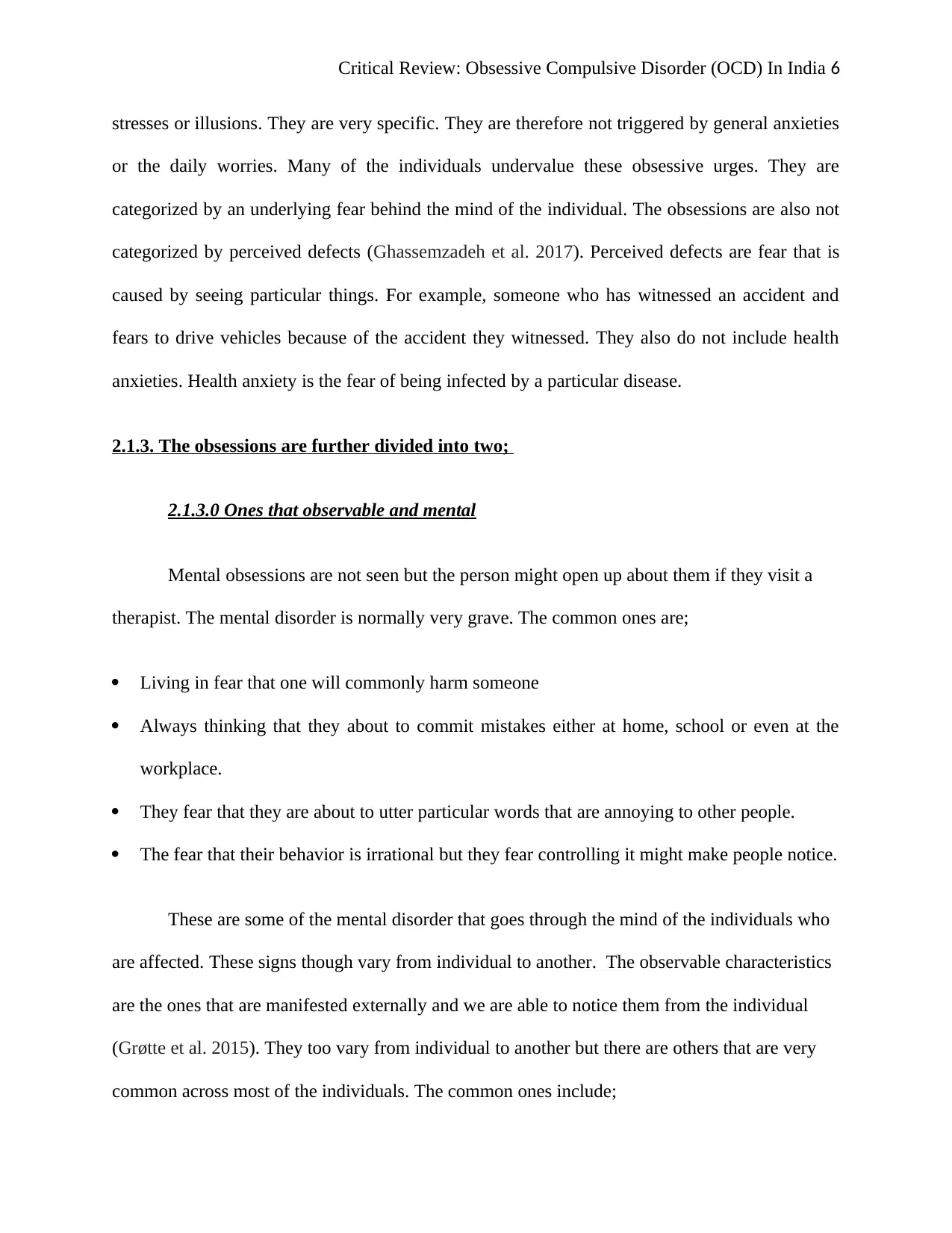
Critical Review: Obsessive Compulsive Disorder (OCD) In India 6
stresses or illusions. They are very specific. They are therefore not triggered by general anxieties
or the daily worries. Many of the individuals undervalue these obsessive urges. They are
categorized by an underlying fear behind the mind of the individual. The obsessions are also not
categorized by perceived defects (Ghassemzadeh et al. 2017). Perceived defects are fear that is
caused by seeing particular things. For example, someone who has witnessed an accident and
fears to drive vehicles because of the accident they witnessed. They also do not include health
anxieties. Health anxiety is the fear of being infected by a particular disease.
2.1.3. The obsessions are further divided into two;
2.1.3.0 Ones that observable and mental
Mental obsessions are not seen but the person might open up about them if they visit a
therapist. The mental disorder is normally very grave. The common ones are;
Living in fear that one will commonly harm someone
Always thinking that they about to commit mistakes either at home, school or even at the
workplace.
They fear that they are about to utter particular words that are annoying to other people.
The fear that their behavior is irrational but they fear controlling it might make people notice.
These are some of the mental disorder that goes through the mind of the individuals who
are affected. These signs though vary from individual to another. The observable characteristics
are the ones that are manifested externally and we are able to notice them from the individual
(Grøtte et al. 2015). They too vary from individual to another but there are others that are very
common across most of the individuals. The common ones include;
stresses or illusions. They are very specific. They are therefore not triggered by general anxieties
or the daily worries. Many of the individuals undervalue these obsessive urges. They are
categorized by an underlying fear behind the mind of the individual. The obsessions are also not
categorized by perceived defects (Ghassemzadeh et al. 2017). Perceived defects are fear that is
caused by seeing particular things. For example, someone who has witnessed an accident and
fears to drive vehicles because of the accident they witnessed. They also do not include health
anxieties. Health anxiety is the fear of being infected by a particular disease.
2.1.3. The obsessions are further divided into two;
2.1.3.0 Ones that observable and mental
Mental obsessions are not seen but the person might open up about them if they visit a
therapist. The mental disorder is normally very grave. The common ones are;
Living in fear that one will commonly harm someone
Always thinking that they about to commit mistakes either at home, school or even at the
workplace.
They fear that they are about to utter particular words that are annoying to other people.
The fear that their behavior is irrational but they fear controlling it might make people notice.
These are some of the mental disorder that goes through the mind of the individuals who
are affected. These signs though vary from individual to another. The observable characteristics
are the ones that are manifested externally and we are able to notice them from the individual
(Grøtte et al. 2015). They too vary from individual to another but there are others that are very
common across most of the individuals. The common ones include;
⊘ This is a preview!⊘
Do you want full access?
Subscribe today to unlock all pages.

Trusted by 1+ million students worldwide
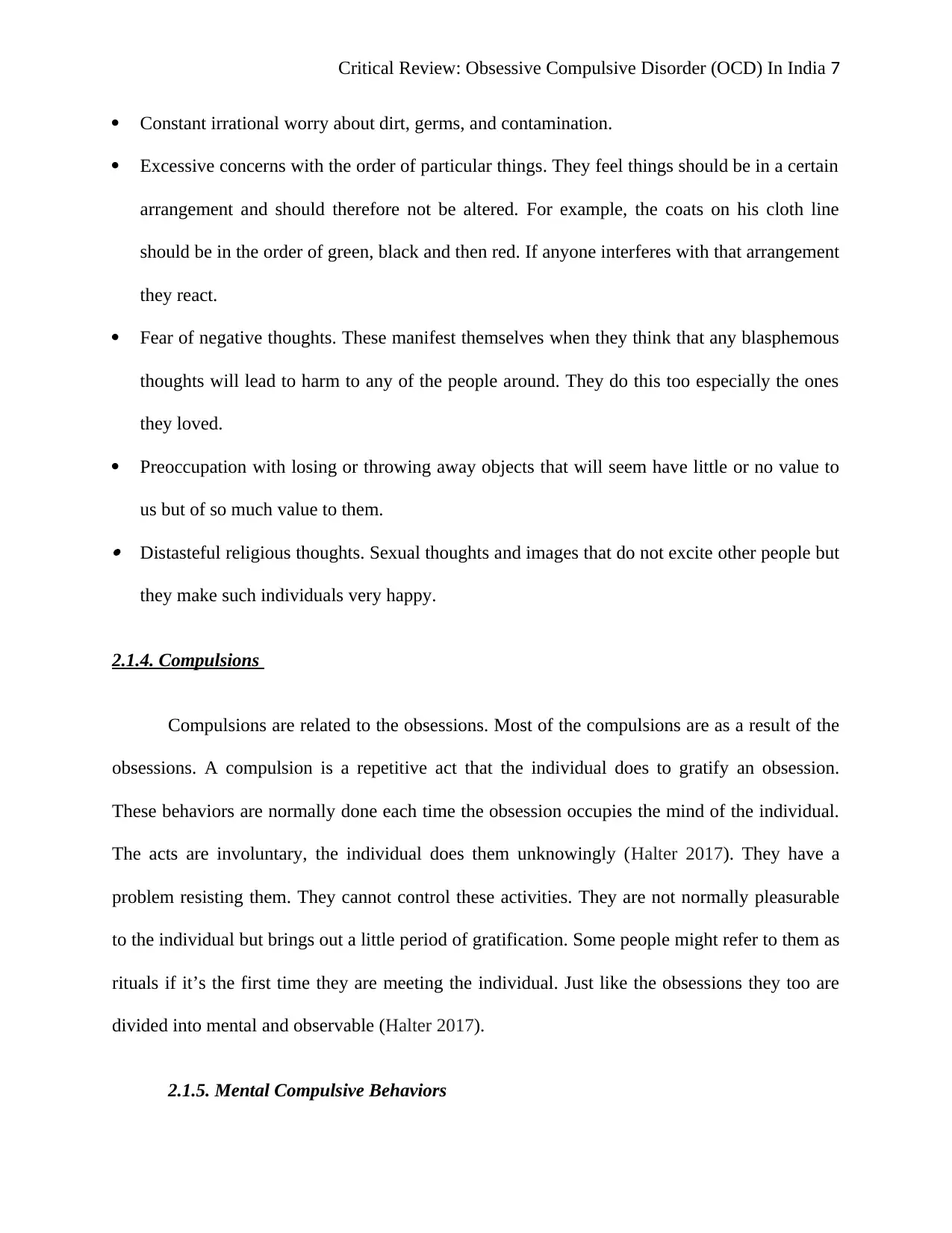
Critical Review: Obsessive Compulsive Disorder (OCD) In India 7
Constant irrational worry about dirt, germs, and contamination.
Excessive concerns with the order of particular things. They feel things should be in a certain
arrangement and should therefore not be altered. For example, the coats on his cloth line
should be in the order of green, black and then red. If anyone interferes with that arrangement
they react.
Fear of negative thoughts. These manifest themselves when they think that any blasphemous
thoughts will lead to harm to any of the people around. They do this too especially the ones
they loved.
Preoccupation with losing or throwing away objects that will seem have little or no value to
us but of so much value to them.
Distasteful religious thoughts. Sexual thoughts and images that do not excite other people but
they make such individuals very happy.
2.1.4. Compulsions
Compulsions are related to the obsessions. Most of the compulsions are as a result of the
obsessions. A compulsion is a repetitive act that the individual does to gratify an obsession.
These behaviors are normally done each time the obsession occupies the mind of the individual.
The acts are involuntary, the individual does them unknowingly (Halter 2017). They have a
problem resisting them. They cannot control these activities. They are not normally pleasurable
to the individual but brings out a little period of gratification. Some people might refer to them as
rituals if it’s the first time they are meeting the individual. Just like the obsessions they too are
divided into mental and observable (Halter 2017).
2.1.5. Mental Compulsive Behaviors
Constant irrational worry about dirt, germs, and contamination.
Excessive concerns with the order of particular things. They feel things should be in a certain
arrangement and should therefore not be altered. For example, the coats on his cloth line
should be in the order of green, black and then red. If anyone interferes with that arrangement
they react.
Fear of negative thoughts. These manifest themselves when they think that any blasphemous
thoughts will lead to harm to any of the people around. They do this too especially the ones
they loved.
Preoccupation with losing or throwing away objects that will seem have little or no value to
us but of so much value to them.
Distasteful religious thoughts. Sexual thoughts and images that do not excite other people but
they make such individuals very happy.
2.1.4. Compulsions
Compulsions are related to the obsessions. Most of the compulsions are as a result of the
obsessions. A compulsion is a repetitive act that the individual does to gratify an obsession.
These behaviors are normally done each time the obsession occupies the mind of the individual.
The acts are involuntary, the individual does them unknowingly (Halter 2017). They have a
problem resisting them. They cannot control these activities. They are not normally pleasurable
to the individual but brings out a little period of gratification. Some people might refer to them as
rituals if it’s the first time they are meeting the individual. Just like the obsessions they too are
divided into mental and observable (Halter 2017).
2.1.5. Mental Compulsive Behaviors
Paraphrase This Document
Need a fresh take? Get an instant paraphrase of this document with our AI Paraphraser
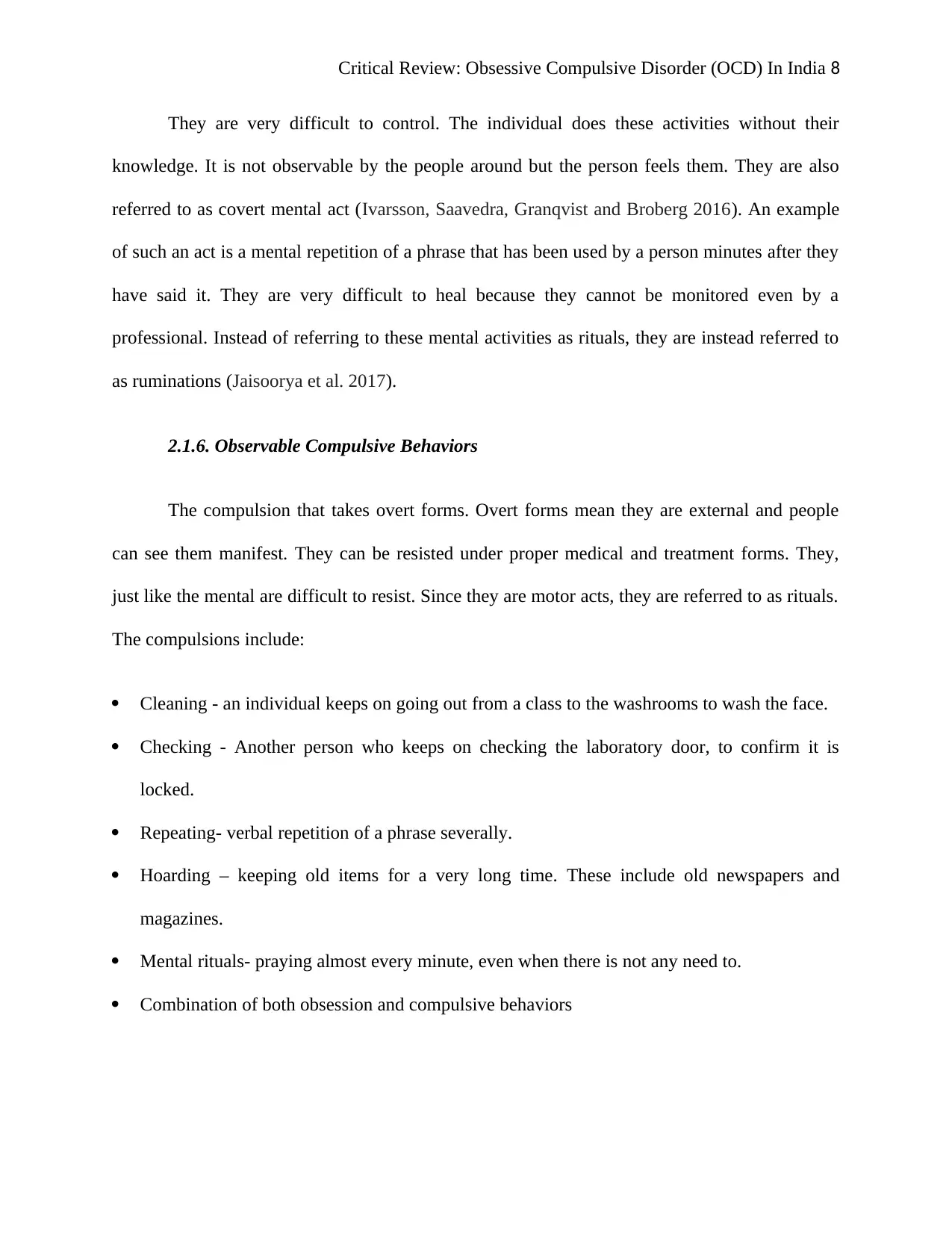
Critical Review: Obsessive Compulsive Disorder (OCD) In India 8
They are very difficult to control. The individual does these activities without their
knowledge. It is not observable by the people around but the person feels them. They are also
referred to as covert mental act (Ivarsson, Saavedra, Granqvist and Broberg 2016). An example
of such an act is a mental repetition of a phrase that has been used by a person minutes after they
have said it. They are very difficult to heal because they cannot be monitored even by a
professional. Instead of referring to these mental activities as rituals, they are instead referred to
as ruminations (Jaisoorya et al. 2017).
2.1.6. Observable Compulsive Behaviors
The compulsion that takes overt forms. Overt forms mean they are external and people
can see them manifest. They can be resisted under proper medical and treatment forms. They,
just like the mental are difficult to resist. Since they are motor acts, they are referred to as rituals.
The compulsions include:
Cleaning - an individual keeps on going out from a class to the washrooms to wash the face.
Checking - Another person who keeps on checking the laboratory door, to confirm it is
locked.
Repeating- verbal repetition of a phrase severally.
Hoarding – keeping old items for a very long time. These include old newspapers and
magazines.
Mental rituals- praying almost every minute, even when there is not any need to.
Combination of both obsession and compulsive behaviors
They are very difficult to control. The individual does these activities without their
knowledge. It is not observable by the people around but the person feels them. They are also
referred to as covert mental act (Ivarsson, Saavedra, Granqvist and Broberg 2016). An example
of such an act is a mental repetition of a phrase that has been used by a person minutes after they
have said it. They are very difficult to heal because they cannot be monitored even by a
professional. Instead of referring to these mental activities as rituals, they are instead referred to
as ruminations (Jaisoorya et al. 2017).
2.1.6. Observable Compulsive Behaviors
The compulsion that takes overt forms. Overt forms mean they are external and people
can see them manifest. They can be resisted under proper medical and treatment forms. They,
just like the mental are difficult to resist. Since they are motor acts, they are referred to as rituals.
The compulsions include:
Cleaning - an individual keeps on going out from a class to the washrooms to wash the face.
Checking - Another person who keeps on checking the laboratory door, to confirm it is
locked.
Repeating- verbal repetition of a phrase severally.
Hoarding – keeping old items for a very long time. These include old newspapers and
magazines.
Mental rituals- praying almost every minute, even when there is not any need to.
Combination of both obsession and compulsive behaviors
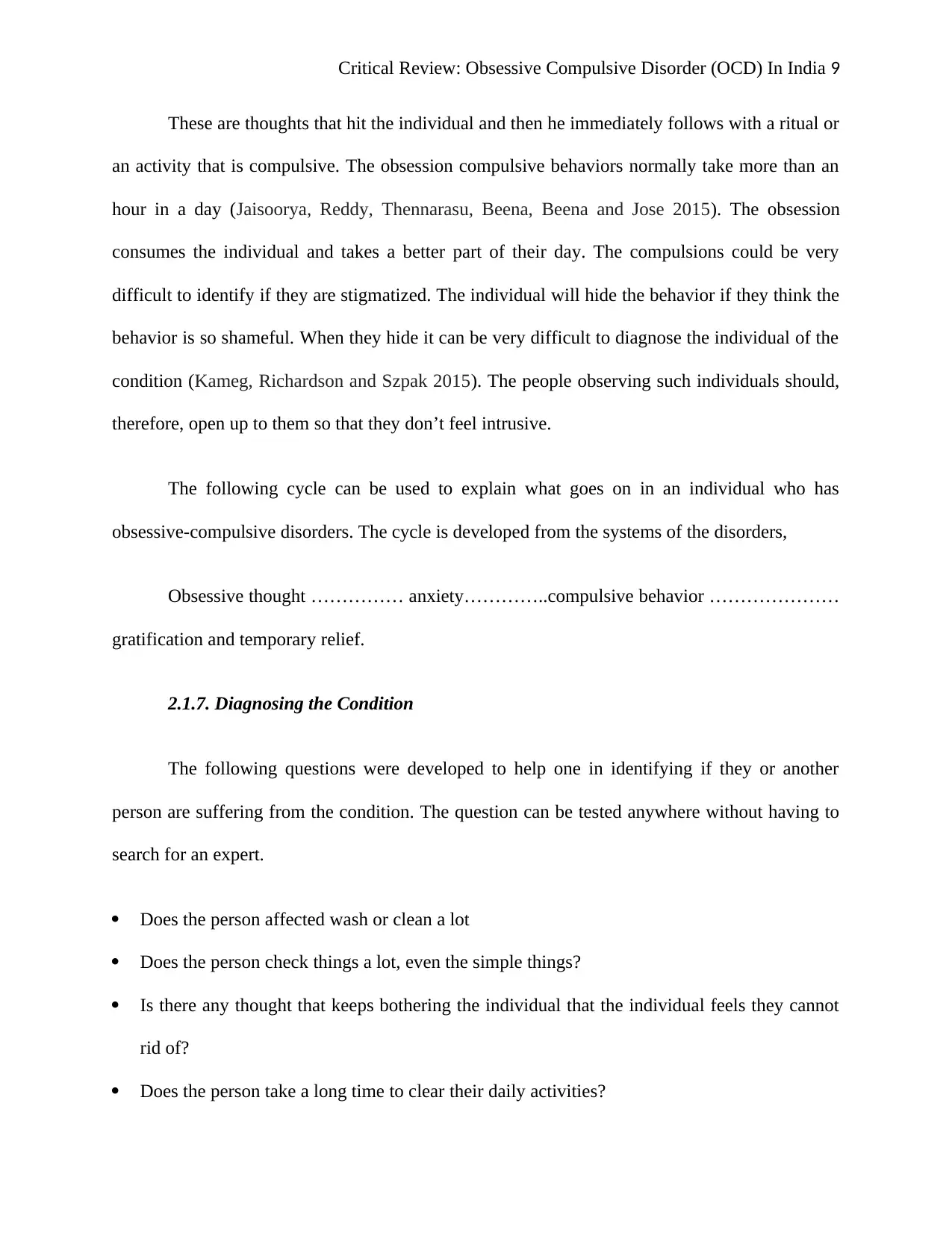
Critical Review: Obsessive Compulsive Disorder (OCD) In India 9
These are thoughts that hit the individual and then he immediately follows with a ritual or
an activity that is compulsive. The obsession compulsive behaviors normally take more than an
hour in a day (Jaisoorya, Reddy, Thennarasu, Beena, Beena and Jose 2015). The obsession
consumes the individual and takes a better part of their day. The compulsions could be very
difficult to identify if they are stigmatized. The individual will hide the behavior if they think the
behavior is so shameful. When they hide it can be very difficult to diagnose the individual of the
condition (Kameg, Richardson and Szpak 2015). The people observing such individuals should,
therefore, open up to them so that they don’t feel intrusive.
The following cycle can be used to explain what goes on in an individual who has
obsessive-compulsive disorders. The cycle is developed from the systems of the disorders,
Obsessive thought …………… anxiety…………..compulsive behavior …………………
gratification and temporary relief.
2.1.7. Diagnosing the Condition
The following questions were developed to help one in identifying if they or another
person are suffering from the condition. The question can be tested anywhere without having to
search for an expert.
Does the person affected wash or clean a lot
Does the person check things a lot, even the simple things?
Is there any thought that keeps bothering the individual that the individual feels they cannot
rid of?
Does the person take a long time to clear their daily activities?
These are thoughts that hit the individual and then he immediately follows with a ritual or
an activity that is compulsive. The obsession compulsive behaviors normally take more than an
hour in a day (Jaisoorya, Reddy, Thennarasu, Beena, Beena and Jose 2015). The obsession
consumes the individual and takes a better part of their day. The compulsions could be very
difficult to identify if they are stigmatized. The individual will hide the behavior if they think the
behavior is so shameful. When they hide it can be very difficult to diagnose the individual of the
condition (Kameg, Richardson and Szpak 2015). The people observing such individuals should,
therefore, open up to them so that they don’t feel intrusive.
The following cycle can be used to explain what goes on in an individual who has
obsessive-compulsive disorders. The cycle is developed from the systems of the disorders,
Obsessive thought …………… anxiety…………..compulsive behavior …………………
gratification and temporary relief.
2.1.7. Diagnosing the Condition
The following questions were developed to help one in identifying if they or another
person are suffering from the condition. The question can be tested anywhere without having to
search for an expert.
Does the person affected wash or clean a lot
Does the person check things a lot, even the simple things?
Is there any thought that keeps bothering the individual that the individual feels they cannot
rid of?
Does the person take a long time to clear their daily activities?
⊘ This is a preview!⊘
Do you want full access?
Subscribe today to unlock all pages.

Trusted by 1+ million students worldwide
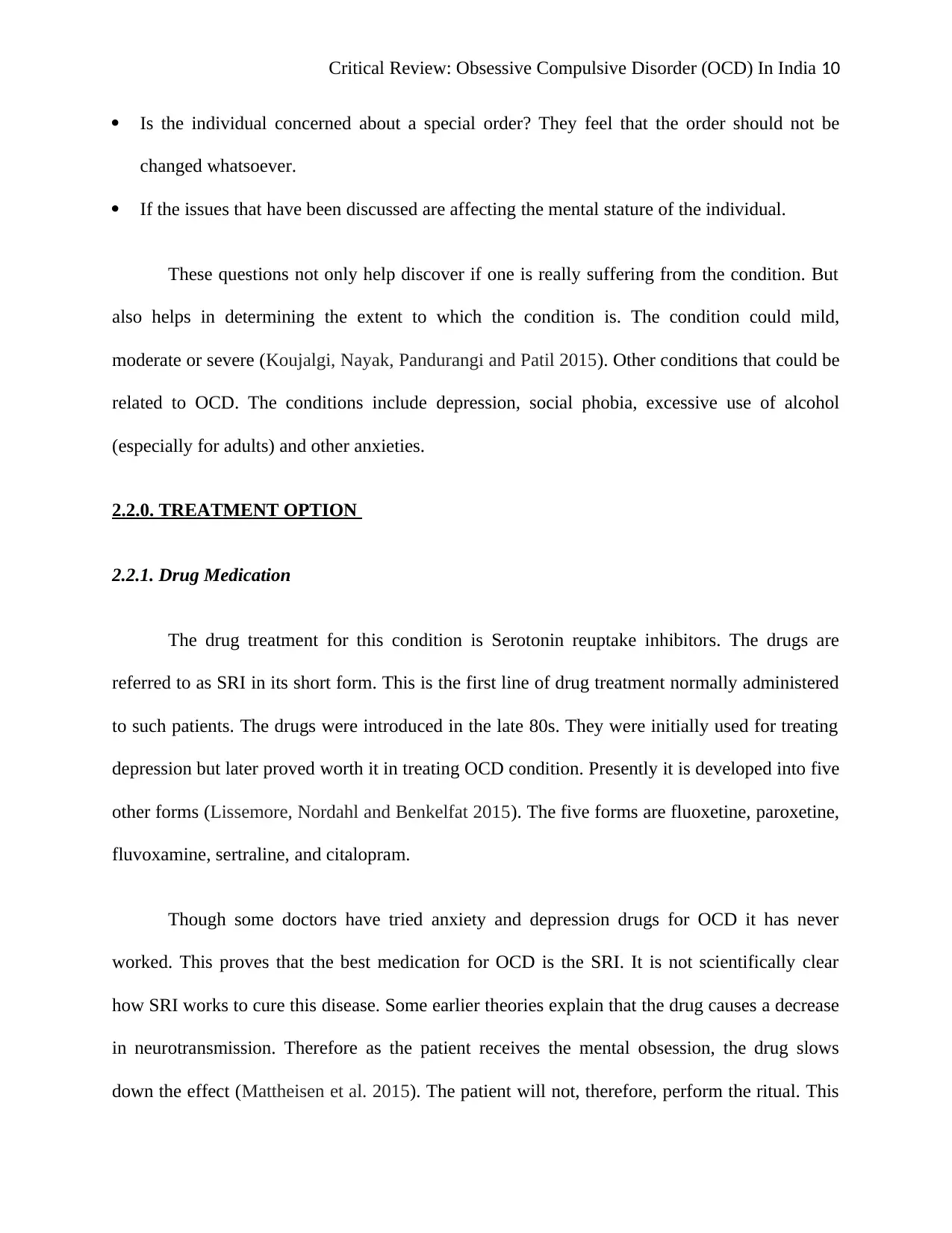
Critical Review: Obsessive Compulsive Disorder (OCD) In India 10
Is the individual concerned about a special order? They feel that the order should not be
changed whatsoever.
If the issues that have been discussed are affecting the mental stature of the individual.
These questions not only help discover if one is really suffering from the condition. But
also helps in determining the extent to which the condition is. The condition could mild,
moderate or severe (Koujalgi, Nayak, Pandurangi and Patil 2015). Other conditions that could be
related to OCD. The conditions include depression, social phobia, excessive use of alcohol
(especially for adults) and other anxieties.
2.2.0. TREATMENT OPTION
2.2.1. Drug Medication
The drug treatment for this condition is Serotonin reuptake inhibitors. The drugs are
referred to as SRI in its short form. This is the first line of drug treatment normally administered
to such patients. The drugs were introduced in the late 80s. They were initially used for treating
depression but later proved worth it in treating OCD condition. Presently it is developed into five
other forms (Lissemore, Nordahl and Benkelfat 2015). The five forms are fluoxetine, paroxetine,
fluvoxamine, sertraline, and citalopram.
Though some doctors have tried anxiety and depression drugs for OCD it has never
worked. This proves that the best medication for OCD is the SRI. It is not scientifically clear
how SRI works to cure this disease. Some earlier theories explain that the drug causes a decrease
in neurotransmission. Therefore as the patient receives the mental obsession, the drug slows
down the effect (Mattheisen et al. 2015). The patient will not, therefore, perform the ritual. This
Is the individual concerned about a special order? They feel that the order should not be
changed whatsoever.
If the issues that have been discussed are affecting the mental stature of the individual.
These questions not only help discover if one is really suffering from the condition. But
also helps in determining the extent to which the condition is. The condition could mild,
moderate or severe (Koujalgi, Nayak, Pandurangi and Patil 2015). Other conditions that could be
related to OCD. The conditions include depression, social phobia, excessive use of alcohol
(especially for adults) and other anxieties.
2.2.0. TREATMENT OPTION
2.2.1. Drug Medication
The drug treatment for this condition is Serotonin reuptake inhibitors. The drugs are
referred to as SRI in its short form. This is the first line of drug treatment normally administered
to such patients. The drugs were introduced in the late 80s. They were initially used for treating
depression but later proved worth it in treating OCD condition. Presently it is developed into five
other forms (Lissemore, Nordahl and Benkelfat 2015). The five forms are fluoxetine, paroxetine,
fluvoxamine, sertraline, and citalopram.
Though some doctors have tried anxiety and depression drugs for OCD it has never
worked. This proves that the best medication for OCD is the SRI. It is not scientifically clear
how SRI works to cure this disease. Some earlier theories explain that the drug causes a decrease
in neurotransmission. Therefore as the patient receives the mental obsession, the drug slows
down the effect (Mattheisen et al. 2015). The patient will not, therefore, perform the ritual. This
Paraphrase This Document
Need a fresh take? Get an instant paraphrase of this document with our AI Paraphraser
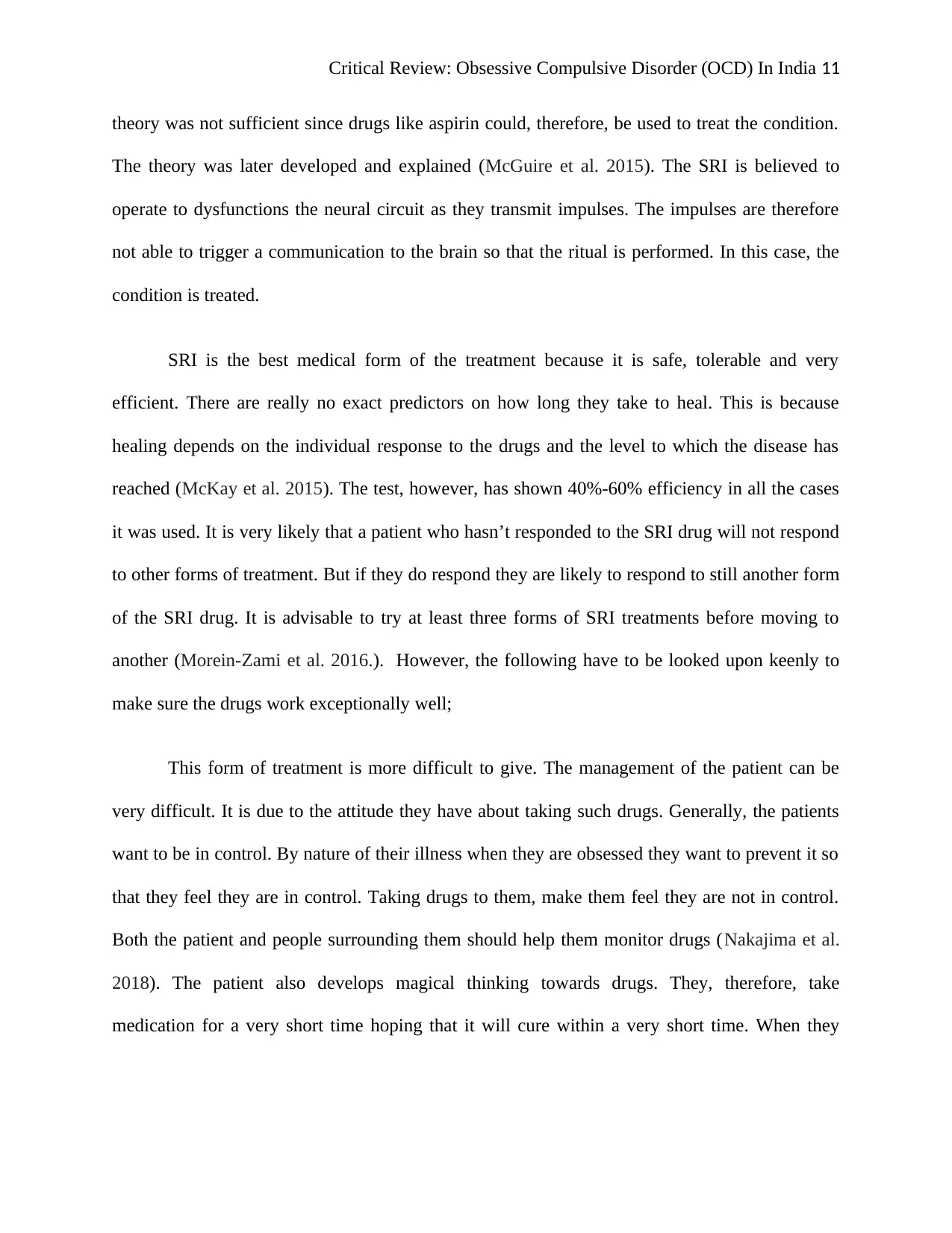
Critical Review: Obsessive Compulsive Disorder (OCD) In India 11
theory was not sufficient since drugs like aspirin could, therefore, be used to treat the condition.
The theory was later developed and explained (McGuire et al. 2015). The SRI is believed to
operate to dysfunctions the neural circuit as they transmit impulses. The impulses are therefore
not able to trigger a communication to the brain so that the ritual is performed. In this case, the
condition is treated.
SRI is the best medical form of the treatment because it is safe, tolerable and very
efficient. There are really no exact predictors on how long they take to heal. This is because
healing depends on the individual response to the drugs and the level to which the disease has
reached (McKay et al. 2015). The test, however, has shown 40%-60% efficiency in all the cases
it was used. It is very likely that a patient who hasn’t responded to the SRI drug will not respond
to other forms of treatment. But if they do respond they are likely to respond to still another form
of the SRI drug. It is advisable to try at least three forms of SRI treatments before moving to
another (Morein-Zami et al. 2016.). However, the following have to be looked upon keenly to
make sure the drugs work exceptionally well;
This form of treatment is more difficult to give. The management of the patient can be
very difficult. It is due to the attitude they have about taking such drugs. Generally, the patients
want to be in control. By nature of their illness when they are obsessed they want to prevent it so
that they feel they are in control. Taking drugs to them, make them feel they are not in control.
Both the patient and people surrounding them should help them monitor drugs (Nakajima et al.
2018). The patient also develops magical thinking towards drugs. They, therefore, take
medication for a very short time hoping that it will cure within a very short time. When they
theory was not sufficient since drugs like aspirin could, therefore, be used to treat the condition.
The theory was later developed and explained (McGuire et al. 2015). The SRI is believed to
operate to dysfunctions the neural circuit as they transmit impulses. The impulses are therefore
not able to trigger a communication to the brain so that the ritual is performed. In this case, the
condition is treated.
SRI is the best medical form of the treatment because it is safe, tolerable and very
efficient. There are really no exact predictors on how long they take to heal. This is because
healing depends on the individual response to the drugs and the level to which the disease has
reached (McKay et al. 2015). The test, however, has shown 40%-60% efficiency in all the cases
it was used. It is very likely that a patient who hasn’t responded to the SRI drug will not respond
to other forms of treatment. But if they do respond they are likely to respond to still another form
of the SRI drug. It is advisable to try at least three forms of SRI treatments before moving to
another (Morein-Zami et al. 2016.). However, the following have to be looked upon keenly to
make sure the drugs work exceptionally well;
This form of treatment is more difficult to give. The management of the patient can be
very difficult. It is due to the attitude they have about taking such drugs. Generally, the patients
want to be in control. By nature of their illness when they are obsessed they want to prevent it so
that they feel they are in control. Taking drugs to them, make them feel they are not in control.
Both the patient and people surrounding them should help them monitor drugs (Nakajima et al.
2018). The patient also develops magical thinking towards drugs. They, therefore, take
medication for a very short time hoping that it will cure within a very short time. When they
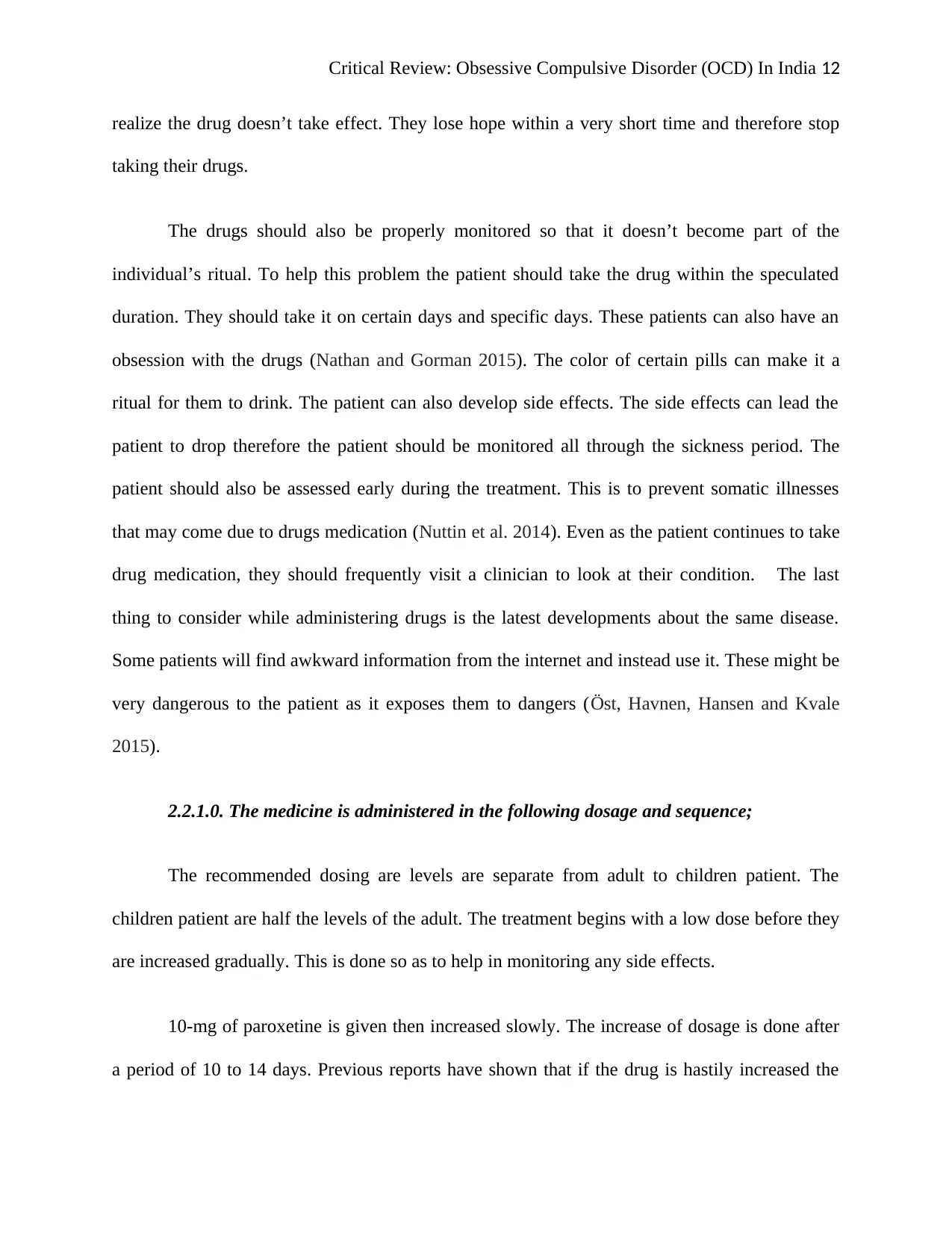
Critical Review: Obsessive Compulsive Disorder (OCD) In India 12
realize the drug doesn’t take effect. They lose hope within a very short time and therefore stop
taking their drugs.
The drugs should also be properly monitored so that it doesn’t become part of the
individual’s ritual. To help this problem the patient should take the drug within the speculated
duration. They should take it on certain days and specific days. These patients can also have an
obsession with the drugs (Nathan and Gorman 2015). The color of certain pills can make it a
ritual for them to drink. The patient can also develop side effects. The side effects can lead the
patient to drop therefore the patient should be monitored all through the sickness period. The
patient should also be assessed early during the treatment. This is to prevent somatic illnesses
that may come due to drugs medication (Nuttin et al. 2014). Even as the patient continues to take
drug medication, they should frequently visit a clinician to look at their condition. The last
thing to consider while administering drugs is the latest developments about the same disease.
Some patients will find awkward information from the internet and instead use it. These might be
very dangerous to the patient as it exposes them to dangers (Öst, Havnen, Hansen and Kvale
2015).
2.2.1.0. The medicine is administered in the following dosage and sequence;
The recommended dosing are levels are separate from adult to children patient. The
children patient are half the levels of the adult. The treatment begins with a low dose before they
are increased gradually. This is done so as to help in monitoring any side effects.
10-mg of paroxetine is given then increased slowly. The increase of dosage is done after
a period of 10 to 14 days. Previous reports have shown that if the drug is hastily increased the
realize the drug doesn’t take effect. They lose hope within a very short time and therefore stop
taking their drugs.
The drugs should also be properly monitored so that it doesn’t become part of the
individual’s ritual. To help this problem the patient should take the drug within the speculated
duration. They should take it on certain days and specific days. These patients can also have an
obsession with the drugs (Nathan and Gorman 2015). The color of certain pills can make it a
ritual for them to drink. The patient can also develop side effects. The side effects can lead the
patient to drop therefore the patient should be monitored all through the sickness period. The
patient should also be assessed early during the treatment. This is to prevent somatic illnesses
that may come due to drugs medication (Nuttin et al. 2014). Even as the patient continues to take
drug medication, they should frequently visit a clinician to look at their condition. The last
thing to consider while administering drugs is the latest developments about the same disease.
Some patients will find awkward information from the internet and instead use it. These might be
very dangerous to the patient as it exposes them to dangers (Öst, Havnen, Hansen and Kvale
2015).
2.2.1.0. The medicine is administered in the following dosage and sequence;
The recommended dosing are levels are separate from adult to children patient. The
children patient are half the levels of the adult. The treatment begins with a low dose before they
are increased gradually. This is done so as to help in monitoring any side effects.
10-mg of paroxetine is given then increased slowly. The increase of dosage is done after
a period of 10 to 14 days. Previous reports have shown that if the drug is hastily increased the
⊘ This is a preview!⊘
Do you want full access?
Subscribe today to unlock all pages.

Trusted by 1+ million students worldwide
1 out of 32
Related Documents
Your All-in-One AI-Powered Toolkit for Academic Success.
+13062052269
info@desklib.com
Available 24*7 on WhatsApp / Email
![[object Object]](/_next/static/media/star-bottom.7253800d.svg)
Unlock your academic potential
Copyright © 2020–2025 A2Z Services. All Rights Reserved. Developed and managed by ZUCOL.





